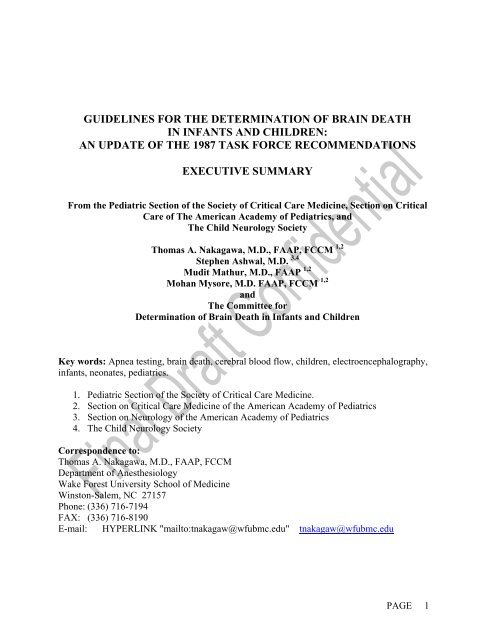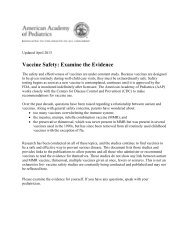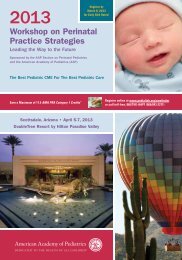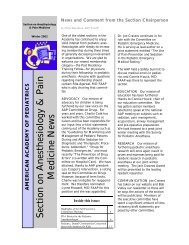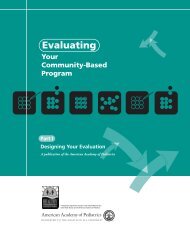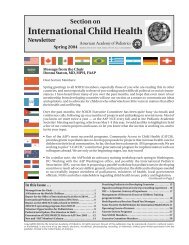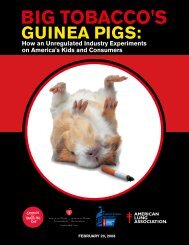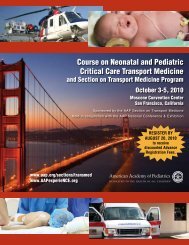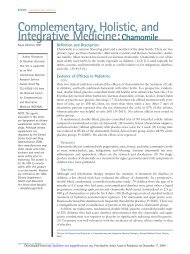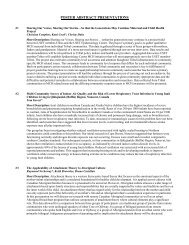guidelines for the determination of brain death in infants and children
guidelines for the determination of brain death in infants and children
guidelines for the determination of brain death in infants and children
Create successful ePaper yourself
Turn your PDF publications into a flip-book with our unique Google optimized e-Paper software.
GUIDELINES FOR THE DETERMINATION OF BRAIN DEATH<br />
IN INFANTS AND CHILDREN:<br />
AN UPDATE OF THE 1987 TASK FORCE RECOMMENDATIONS<br />
EXECUTIVE SUMMARY<br />
From <strong>the</strong> Pediatric Section <strong>of</strong> <strong>the</strong> Society <strong>of</strong> Critical Care Medic<strong>in</strong>e, Section on Critical<br />
Care <strong>of</strong> The American Academy <strong>of</strong> Pediatrics, <strong>and</strong><br />
The Child Neurology Society<br />
Thomas A. Nakagawa, M.D., FAAP, FCCM 1,2<br />
Stephen Ashwal, M.D. 3,4<br />
Mudit Mathur, M.D., FAAP 1,2<br />
Mohan Mysore, M.D. FAAP, FCCM 1,2<br />
<strong>and</strong><br />
The Committee <strong>for</strong><br />
Determ<strong>in</strong>ation <strong>of</strong> Bra<strong>in</strong> Death <strong>in</strong> Infants <strong>and</strong> Children<br />
Key words: Apnea test<strong>in</strong>g, <strong>bra<strong>in</strong></strong> <strong>death</strong>, cerebral blood flow, <strong>children</strong>, electroencephalography,<br />
<strong>in</strong>fants, neonates, pediatrics.<br />
1. Pediatric Section <strong>of</strong> <strong>the</strong> Society <strong>of</strong> Critical Care Medic<strong>in</strong>e.<br />
2. Section on Critical Care Medic<strong>in</strong>e <strong>of</strong> <strong>the</strong> American Academy <strong>of</strong> Pediatrics<br />
3. Section on Neurology <strong>of</strong> <strong>the</strong> American Academy <strong>of</strong> Pediatrics<br />
4. The Child Neurology Society<br />
Correspondence to:<br />
Thomas A. Nakagawa, M.D., FAAP, FCCM<br />
Department <strong>of</strong> Anes<strong>the</strong>siology<br />
Wake Forest University School <strong>of</strong> Medic<strong>in</strong>e<br />
W<strong>in</strong>ston-Salem, NC 27157<br />
Phone: (336) 716-7194<br />
FAX: (336) 716-8190<br />
E-mail: HYPERLINK "mailto:tnakagaw@wfubmc.edu" tnakagaw@wfubmc.edu<br />
PAGE 1
Task<strong>for</strong>ce Committee Members<br />
Stephen Ashwal, M.D. Pr<strong>of</strong>essor <strong>of</strong> Pediatrics. Department <strong>of</strong> Pediatrics, Chief, Division <strong>of</strong><br />
Child Neurology. Loma L<strong>in</strong>da University School <strong>of</strong> Medic<strong>in</strong>e. Loma L<strong>in</strong>da, CA<br />
Derek Bruce, M.D. Pr<strong>of</strong>essor <strong>of</strong> Neurosurgery <strong>and</strong> Pediatrics. Children’s National Medical<br />
Center, Wash<strong>in</strong>gton, DC<br />
Edward E. Conway Jr. M.D. FCCM. Pr<strong>of</strong>essor <strong>of</strong> Pediatrics. Beth Israel Medical Center,<br />
Hartsdale, NY<br />
Susan E Duthie, M.D. Pediatric Critical Care. Rady Children’s Hospital-San Diego, San Diego,<br />
CA<br />
Shannon Hamrick, M.D. Assistant Pr<strong>of</strong>essor <strong>of</strong> Pediatrics. Emory University, Children’s<br />
Healthcare <strong>of</strong> Atlanta. Atlanta GA<br />
Rick Harrison, M.D. Pr<strong>of</strong>essor <strong>of</strong> Pediatrics. David Geffen School <strong>of</strong> Medic<strong>in</strong>e UCLA. Medical<br />
Director Mattel Children’s Hospital UCLA. Los Angeles, CA<br />
Andrea M. Kl<strong>in</strong>e, RN, FCCM. Nurse Practitioner. Riley Hospital <strong>for</strong> Children. Indianapolis, IN<br />
Daniel J. Lebovitz, M.D. Associate Pr<strong>of</strong>essor <strong>of</strong> Pediatrics. Clevel<strong>and</strong> Cl<strong>in</strong>ic Lerner College <strong>of</strong><br />
Medic<strong>in</strong>e. Clevel<strong>and</strong> Cl<strong>in</strong>ic Children’s Hospital, Clevel<strong>and</strong>, OH<br />
Maureen A. Madden, MSN. FCCM. Assistant Pr<strong>of</strong>essor <strong>of</strong> Pediatrics. Robert Wood Johnson<br />
Medical School. Pediatric Critical Care Nurse Practitioner. Bristol-Myers Squibb Children’s<br />
Hospital. New Brunswick, NJ<br />
Mudit Mathur, M.D.,FAAP. Associate Pr<strong>of</strong>essor, Pediatrics. Division <strong>of</strong> Pediatric Critical Care.<br />
Loma L<strong>in</strong>da University School <strong>of</strong> Medic<strong>in</strong>e. Loma L<strong>in</strong>da, CA<br />
Vicki L. Montgomery, M.D.FCCM. Pr<strong>of</strong>essor <strong>of</strong> Pediatrics. University <strong>of</strong> Louisville. Chief,<br />
Division <strong>of</strong> Pediatric Critical Care Medic<strong>in</strong>e. Medical Director. Patient Safety Officer. Norton<br />
Healthcare Kosair Children’s Hospital. Louisville, KY<br />
Mohan R. Mysore, MD, FAAP, FCCM. Pr<strong>of</strong>essor <strong>of</strong> Pediatrics, University <strong>of</strong> Nebraska College<br />
<strong>of</strong> Medic<strong>in</strong>e. Director Pediatric Critical Care. Children’s Hospital <strong>and</strong> Medical Center. Omaha,<br />
NE<br />
Thomas A. Nakagawa, M.D. FAAP, FCCM. Pr<strong>of</strong>essor Anes<strong>the</strong>siology <strong>and</strong> Pediatrics. Wake<br />
Forest University School <strong>of</strong> Medic<strong>in</strong>e. Director, Pediatric Critical Care. Brenner Children’s<br />
Hospital at Wake Forest University Baptist Medical Center. W<strong>in</strong>ston-Salem, NC<br />
Jeffrey M. Perlman MB. Pr<strong>of</strong>essor <strong>of</strong> Pediatrics. Weill Cornell Medical College. New York, NY<br />
PAGE 2
Nancy Roll<strong>in</strong>s, M.D. Pr<strong>of</strong>essor <strong>of</strong> Pediatrics <strong>and</strong> Radiology. Children’s Medical Center.<br />
Southwestern University, Dallas, Texas<br />
Sam D. Shemie, M.D. Pr<strong>of</strong>essor <strong>of</strong> Pediatrics. Montreal Children’s Hospital. Montreal, Canada<br />
Amit Vohra, M.D. FAAP. Assistant Pr<strong>of</strong>essor <strong>of</strong> Pediatrics, Wright State University, Pediatric<br />
Critical Care, Children’s Medical Center. Dayton, OH.<br />
Jacquel<strong>in</strong>e A. Williams-Phillips, M.D. FAAP, FCCM. Associate Pr<strong>of</strong>essor <strong>of</strong> Pediatrics.<br />
UMDNJ-Robert Wood Johnson Medical School. Director, Pediatric Intensive Care Unit.<br />
Bristol-Myers Squibb Children’s Hospital. New Brunswick, NJ<br />
PAGE 3
ABSTRACT<br />
Objective: To review <strong>and</strong> revise <strong>the</strong> 1987 pediatric <strong>bra<strong>in</strong></strong> <strong>death</strong> <strong>guidel<strong>in</strong>es</strong>.<br />
Methods: Relevant literature was reviewed. Recommendations were developed us<strong>in</strong>g <strong>the</strong><br />
GRADE system.<br />
Conclusions <strong>and</strong> Recommendations:<br />
(1) Determ<strong>in</strong>ation <strong>of</strong> <strong>bra<strong>in</strong></strong> <strong>death</strong> <strong>in</strong> term newborns, <strong>in</strong>fants <strong>and</strong> <strong>children</strong> is a cl<strong>in</strong>ical diagnosis<br />
based on <strong>the</strong> absence <strong>of</strong> neurologic function with a known irreversible cause <strong>of</strong> coma. Because <strong>of</strong><br />
<strong>in</strong>sufficient data <strong>in</strong> <strong>the</strong> literature, recommendations <strong>for</strong> preterm <strong>in</strong>fants less than 37 weeks<br />
gestational age are not <strong>in</strong>cluded <strong>in</strong> this guidel<strong>in</strong>e.<br />
(2) Hypotension, hypo<strong>the</strong>rmia, <strong>and</strong> metabolic disturbances should be treated <strong>and</strong> corrected <strong>and</strong><br />
medications that can <strong>in</strong>terfere with <strong>the</strong> neurologic exam<strong>in</strong>ation <strong>and</strong> apnea test<strong>in</strong>g should be<br />
discont<strong>in</strong>ued allow<strong>in</strong>g <strong>for</strong> adequate clearance be<strong>for</strong>e proceed<strong>in</strong>g with <strong>the</strong>se evaluations.<br />
(3) Two exam<strong>in</strong>ations <strong>in</strong>clud<strong>in</strong>g apnea test<strong>in</strong>g with each exam<strong>in</strong>ation separated by an<br />
observation period are required. Exam<strong>in</strong>ations should be per<strong>for</strong>med by different attend<strong>in</strong>g<br />
physicians. Apnea test<strong>in</strong>g may be per<strong>for</strong>med by <strong>the</strong> same physician. An observation period <strong>of</strong> 24<br />
hours <strong>for</strong> term newborns (37 weeks gestational age) to 30 days <strong>of</strong> age, <strong>and</strong> 12 hours <strong>for</strong> <strong>in</strong>fants<br />
<strong>and</strong> <strong>children</strong> (> 30 days to 18 years) is recommended. The first exam<strong>in</strong>ation determ<strong>in</strong>es <strong>the</strong> child<br />
has met <strong>the</strong> accepted neurologic exam<strong>in</strong>ation criteria <strong>for</strong> <strong>bra<strong>in</strong></strong> <strong>death</strong>. The second exam<strong>in</strong>ation<br />
confirms <strong>bra<strong>in</strong></strong> <strong>death</strong> based on an unchanged <strong>and</strong> irreversible condition. Assessment <strong>of</strong><br />
neurologic after cardiopulmonary resuscitation or o<strong>the</strong>r severe acute <strong>bra<strong>in</strong></strong> <strong>in</strong>juries should be<br />
deferred <strong>for</strong> 24 hours or longer if <strong>the</strong>re are concerns or <strong>in</strong>consistencies <strong>in</strong> <strong>the</strong> exam<strong>in</strong>ation.<br />
(4) Apnea test<strong>in</strong>g to support <strong>the</strong> diagnosis <strong>of</strong> <strong>bra<strong>in</strong></strong> <strong>death</strong> must be per<strong>for</strong>med safely <strong>and</strong> requires<br />
documentation <strong>of</strong> an arterial PaCO 2 20mm Hg above <strong>the</strong> basel<strong>in</strong>e <strong>and</strong> ≥ 60 mmHg with no<br />
PAGE 4
espiratory ef<strong>for</strong>t dur<strong>in</strong>g <strong>the</strong> test<strong>in</strong>g period. If <strong>the</strong> apnea test cannot be safely completed, an<br />
ancillary study should be per<strong>for</strong>med.<br />
(5) Ancillary studies (electroencephalogram <strong>and</strong> radionuclide cerebral blood flow) are not<br />
required to establish <strong>bra<strong>in</strong></strong> <strong>death</strong> <strong>and</strong> are not a substitute <strong>for</strong> <strong>the</strong> neurologic exam<strong>in</strong>ation.<br />
Ancillary studies may be used to assist <strong>the</strong> cl<strong>in</strong>ician <strong>in</strong> mak<strong>in</strong>g <strong>the</strong> diagnosis <strong>of</strong> <strong>bra<strong>in</strong></strong> <strong>death</strong> a)<br />
when components <strong>of</strong> <strong>the</strong> exam<strong>in</strong>ation or apnea test<strong>in</strong>g cannot be completed safely due to <strong>the</strong><br />
underly<strong>in</strong>g medical condition <strong>of</strong> <strong>the</strong> patient; b) if <strong>the</strong>re is uncerta<strong>in</strong>ty about <strong>the</strong> results <strong>of</strong> <strong>the</strong><br />
neurologic exam<strong>in</strong>ation; c) if a medication effect may be present or d) to reduce <strong>the</strong><br />
<strong>in</strong>terexam<strong>in</strong>ation observation period. When ancillary studies are used, a second cl<strong>in</strong>ical<br />
exam<strong>in</strong>ation <strong>and</strong> apnea test should be per<strong>for</strong>med <strong>and</strong> components that can be completed must<br />
rema<strong>in</strong> consistent with <strong>bra<strong>in</strong></strong> <strong>death</strong>. In this <strong>in</strong>stance <strong>the</strong> observation <strong>in</strong>terval may be shortened<br />
<strong>and</strong> <strong>the</strong> second neurologic exam<strong>in</strong>ation <strong>and</strong> apnea test (or all components that are able to be<br />
completed safely) can be per<strong>for</strong>med at any time <strong>the</strong>reafter.<br />
(6) Death is declared when <strong>the</strong>se above criteria are fulfilled.<br />
PAGE 5
INTRODUCTION<br />
The Pediatric Section <strong>of</strong> <strong>the</strong> Society <strong>of</strong> Critical Care Medic<strong>in</strong>e (SCCM) <strong>and</strong> <strong>the</strong> Section on<br />
Critical Care <strong>of</strong> <strong>the</strong> American Academy <strong>of</strong> Pediatrics (AAP), <strong>in</strong> conjunction with <strong>the</strong> Child<br />
Neurology Society (CNS), <strong>for</strong>med a multidiscipl<strong>in</strong>ary committee <strong>of</strong> medical <strong>and</strong> surgical<br />
subspecialists under <strong>the</strong> auspices <strong>of</strong> <strong>the</strong> American College <strong>of</strong> Critical Care Medic<strong>in</strong>e (ACCM) to<br />
review <strong>and</strong> revise <strong>the</strong> 1987 <strong>guidel<strong>in</strong>es</strong>. Its purpose was to review <strong>the</strong> neonatal <strong>and</strong> pediatric<br />
literature from 1987, <strong>in</strong>clud<strong>in</strong>g any prior relevant literature, <strong>and</strong> update recommendations<br />
regard<strong>in</strong>g appropriate exam<strong>in</strong>ation criteria <strong>and</strong> use <strong>of</strong> ancillary test<strong>in</strong>g to diagnose <strong>bra<strong>in</strong></strong> <strong>death</strong> <strong>in</strong><br />
neonates, <strong>in</strong>fants <strong>and</strong> <strong>children</strong>. The committee was also charged with develop<strong>in</strong>g a checklist to<br />
provide guidance <strong>and</strong> st<strong>and</strong>ardization to determ<strong>in</strong>e <strong>and</strong> document <strong>bra<strong>in</strong></strong> <strong>death</strong>. Uni<strong>for</strong>mity <strong>in</strong> <strong>the</strong><br />
<strong>determ<strong>in</strong>ation</strong> <strong>of</strong> <strong>bra<strong>in</strong></strong> <strong>death</strong> should allow physicians to pronounce <strong>bra<strong>in</strong></strong> <strong>death</strong> <strong>in</strong> pediatric<br />
patients <strong>in</strong> a more precise <strong>and</strong> orderly manner <strong>and</strong> ensure that all components <strong>of</strong> <strong>the</strong> exam<strong>in</strong>ation<br />
are per<strong>for</strong>med <strong>and</strong> appropriately documented. The committee believes <strong>the</strong>se revised diagnostic<br />
<strong>guidel<strong>in</strong>es</strong> (Table 1) <strong>and</strong> a st<strong>and</strong>ardized checklist <strong>for</strong>m (Table 2) will assist physicians <strong>in</strong><br />
determ<strong>in</strong><strong>in</strong>g <strong>and</strong> document<strong>in</strong>g <strong>bra<strong>in</strong></strong> <strong>death</strong> <strong>in</strong> <strong>children</strong>. This should ensure broader acceptance<br />
<strong>and</strong> utilization <strong>of</strong> such uni<strong>for</strong>m criteria.<br />
This update affirms <strong>the</strong> def<strong>in</strong>ition <strong>of</strong> <strong>death</strong> as stated <strong>in</strong> <strong>the</strong> 1987 pediatric <strong>guidel<strong>in</strong>es</strong><br />
established by multiple organizations as follows: “An <strong>in</strong>dividual who has susta<strong>in</strong>ed ei<strong>the</strong>r (1)<br />
irreversible cessation <strong>of</strong> circulatory <strong>and</strong> respiratory functions, or (2) irreversible cessation <strong>of</strong> all<br />
functions <strong>of</strong> <strong>the</strong> entire <strong>bra<strong>in</strong></strong>, <strong>in</strong>clud<strong>in</strong>g <strong>the</strong> <strong>bra<strong>in</strong></strong>stem, is dead. A <strong>determ<strong>in</strong>ation</strong> <strong>of</strong> <strong>death</strong> must be<br />
made <strong>in</strong> accordance with accepted medical st<strong>and</strong>ards (1).”<br />
The committee recognizes that medical judgment <strong>of</strong> <strong>in</strong>volved pediatric specialists will<br />
direct <strong>the</strong> appropriate course <strong>for</strong> <strong>the</strong> medical evaluation <strong>and</strong> diagnosis <strong>of</strong> <strong>bra<strong>in</strong></strong> <strong>death</strong>. The<br />
PAGE 6
committee also recognizes that no national <strong>bra<strong>in</strong></strong> <strong>death</strong> law exists. State statutes <strong>and</strong> policy may<br />
restrict <strong>determ<strong>in</strong>ation</strong> <strong>of</strong> <strong>bra<strong>in</strong></strong> <strong>death</strong> <strong>in</strong> certa<strong>in</strong> circumstances. Physicians should become<br />
familiar with laws <strong>and</strong> policies <strong>in</strong> <strong>the</strong>ir respective <strong>in</strong>stitution. The committee also recognizes that<br />
variability exists <strong>for</strong> <strong>the</strong> age designation <strong>of</strong> pediatric trauma patients. In some states, <strong>the</strong> age <strong>of</strong><br />
<strong>the</strong> pediatric trauma patient is def<strong>in</strong>ed as less than 14 years <strong>of</strong> age. Trauma <strong>and</strong> <strong>in</strong>tensive care<br />
practitioners are encouraged to follow state/local regulations govern<strong>in</strong>g <strong>the</strong> specified age <strong>of</strong><br />
pediatric trauma patients.<br />
The follow<strong>in</strong>g is an Executive Summary <strong>of</strong> <strong>the</strong> recommendations produced from this<br />
committee. The full report is available at: www.ccm website.org. The committee believes <strong>the</strong>se<br />
<strong>guidel<strong>in</strong>es</strong> to be an important step <strong>in</strong> protect<strong>in</strong>g <strong>the</strong> health <strong>and</strong> safety <strong>of</strong> all <strong>in</strong>fants <strong>and</strong> <strong>children</strong>.<br />
These revised cl<strong>in</strong>ical <strong>guidel<strong>in</strong>es</strong> <strong>and</strong> accompany<strong>in</strong>g checklist are <strong>in</strong>tended to provide an updated<br />
framework to promote st<strong>and</strong>ardization <strong>of</strong> <strong>the</strong> neurologic exam <strong>and</strong> use <strong>of</strong> ancillary studies based<br />
on <strong>the</strong> evidence available to <strong>the</strong> committee at <strong>the</strong> time <strong>of</strong> publication.<br />
RECOMMENDATIONS<br />
TERM NEWBORNS (37 WEEKS GESTATIONAL AGE) TO CHILDREN 18 YEARS OF<br />
AGE<br />
Def<strong>in</strong>ition <strong>of</strong> Bra<strong>in</strong> Death <strong>and</strong> Components <strong>of</strong> <strong>the</strong> Cl<strong>in</strong>ical Exam<strong>in</strong>ation<br />
Bra<strong>in</strong> <strong>death</strong> is a cl<strong>in</strong>ical diagnosis based on <strong>the</strong> absence <strong>of</strong> neurologic function with a known<br />
diagnosis that has resulted <strong>in</strong> irreversible coma. Coma <strong>and</strong> apnea must coexist to diagnose <strong>bra<strong>in</strong></strong><br />
<strong>death</strong>. A complete neurologic exam<strong>in</strong>ation that <strong>in</strong>cludes <strong>the</strong> elements outl<strong>in</strong>ed <strong>in</strong> Table 3 is<br />
m<strong>and</strong>atory to determ<strong>in</strong>e <strong>bra<strong>in</strong></strong> <strong>death</strong> with all components appropriately documented. An<br />
algorithm to diagnose <strong>bra<strong>in</strong></strong> <strong>death</strong> <strong>in</strong> <strong>in</strong>fants <strong>and</strong> <strong>children</strong> is provided <strong>in</strong> Figure 1.<br />
PAGE 7
Prerequisites <strong>for</strong> <strong>in</strong>itiat<strong>in</strong>g a cl<strong>in</strong>ical <strong>bra<strong>in</strong></strong> <strong>death</strong> evaluation<br />
Determ<strong>in</strong>ation <strong>of</strong> <strong>bra<strong>in</strong></strong> <strong>death</strong> by neurologic exam<strong>in</strong>ation should be per<strong>for</strong>med <strong>in</strong> <strong>the</strong> sett<strong>in</strong>g<br />
<strong>of</strong> normal age-appropriate physiologic parameters. Factors potentially <strong>in</strong>fluenc<strong>in</strong>g <strong>the</strong> neurologic<br />
exam<strong>in</strong>ation that must be corrected prior to exam<strong>in</strong>ation <strong>and</strong> apnea test<strong>in</strong>g <strong>in</strong>clude: 1) Shock or<br />
persistent hypotension: Systolic blood pressure or MAP should be <strong>in</strong> an acceptable range<br />
(systolic BP not less than 2 SD below age appropriate norm) based on age. Placement <strong>of</strong> an<br />
<strong>in</strong>dwell<strong>in</strong>g arterial ca<strong>the</strong>ter is recommended to ensure that blood pressure rema<strong>in</strong>s with<strong>in</strong> a<br />
normal range dur<strong>in</strong>g <strong>the</strong> process <strong>of</strong> diagnos<strong>in</strong>g <strong>bra<strong>in</strong></strong> <strong>death</strong> <strong>and</strong> to accurately measure PaCO 2<br />
levels dur<strong>in</strong>g apnea test<strong>in</strong>g. 2) Hypo<strong>the</strong>rmia: Hypo<strong>the</strong>rmia is known to depress central nervous<br />
system function (2-4) <strong>and</strong> may lead to a false diagnosis <strong>of</strong> <strong>bra<strong>in</strong></strong> <strong>death</strong>. Hypo<strong>the</strong>rmia may alter<br />
metabolism <strong>and</strong> clearance <strong>of</strong> medications that can <strong>in</strong>terfere with <strong>bra<strong>in</strong></strong> <strong>death</strong> test<strong>in</strong>g. Ef<strong>for</strong>ts to<br />
adequately rewarm be<strong>for</strong>e per<strong>for</strong>m<strong>in</strong>g any neurologic exam<strong>in</strong>ation <strong>and</strong> ma<strong>in</strong>ta<strong>in</strong> temperature<br />
dur<strong>in</strong>g <strong>the</strong> observation period are essential. A core body temperature <strong>of</strong> >35 °C (95°F) should be<br />
achieved <strong>and</strong> ma<strong>in</strong>ta<strong>in</strong>ed dur<strong>in</strong>g exam<strong>in</strong>ation <strong>and</strong> test<strong>in</strong>g to determ<strong>in</strong>e <strong>death</strong>. 3) Severe<br />
metabolic disturbances: Severe metabolic disturbances can cause reversible coma <strong>and</strong> <strong>in</strong>terfere<br />
with <strong>the</strong> cl<strong>in</strong>ical evaluation to determ<strong>in</strong>e <strong>bra<strong>in</strong></strong> <strong>death</strong>. Reversible conditions such as severe<br />
electrolyte imbalances, hyper or hypoglycemia, , severe pH disturbances, severe hepatic or renal<br />
dysfunction, or <strong>in</strong>born errors <strong>of</strong> metabolism may cause coma <strong>in</strong> a neonate, <strong>in</strong>fant or child.(3,4)<br />
These conditions should be identified <strong>and</strong> treated be<strong>for</strong>e evaluation <strong>for</strong> <strong>bra<strong>in</strong></strong> <strong>death</strong>, especially <strong>in</strong><br />
situations where <strong>the</strong> cl<strong>in</strong>ical history does not provide a reasonable explanation <strong>for</strong> <strong>the</strong> neurologic<br />
status <strong>of</strong> <strong>the</strong> child. 4) Drug <strong>in</strong>toxications <strong>in</strong>clud<strong>in</strong>g barbiturates, opioids, sedatives, <strong>in</strong>travenous<br />
<strong>and</strong> <strong>in</strong>halational anes<strong>the</strong>tics, antiepileptic agents, <strong>and</strong> alcohols can cause severe central nervous<br />
system depression <strong>and</strong> may alter <strong>the</strong> cl<strong>in</strong>ical exam<strong>in</strong>ation to <strong>the</strong> po<strong>in</strong>t where <strong>the</strong>y can mimic<br />
PAGE 8
a<strong>in</strong> <strong>death</strong> (3,4). Test<strong>in</strong>g <strong>for</strong> <strong>the</strong>se drugs should be per<strong>for</strong>med if <strong>the</strong>re is concern regard<strong>in</strong>g<br />
recent <strong>in</strong>gestion or adm<strong>in</strong>istration. When available, specific serum levels <strong>of</strong> medications with<br />
sedative properties or side effects should be obta<strong>in</strong>ed <strong>and</strong> documented to be <strong>in</strong> a low to mid<br />
<strong>the</strong>rapeutic range be<strong>for</strong>e neurologic exam<strong>in</strong>ation <strong>for</strong> <strong>bra<strong>in</strong></strong> <strong>death</strong> test<strong>in</strong>g. Adequate clearance<br />
(based on <strong>the</strong> age <strong>of</strong> <strong>the</strong> child, presence <strong>of</strong> organ dysfunction, total amount <strong>of</strong> medication<br />
adm<strong>in</strong>istered, elim<strong>in</strong>ation half-life <strong>of</strong> <strong>the</strong> drug, <strong>and</strong> any active metabolites) should be allowed<br />
prior to <strong>the</strong> neurologic exam<strong>in</strong>ation. In some <strong>in</strong>stances this may require wait<strong>in</strong>g several half-lives<br />
<strong>and</strong> recheck<strong>in</strong>g serum levels <strong>of</strong> <strong>the</strong> medication be<strong>for</strong>e conduct<strong>in</strong>g <strong>the</strong> <strong>bra<strong>in</strong></strong> <strong>death</strong> exam<strong>in</strong>ation. If<br />
neuromuscular-block<strong>in</strong>g agents have been used, <strong>the</strong>y should be stopped <strong>and</strong> adequate clearance<br />
<strong>of</strong> <strong>the</strong>se agents confirmed by use <strong>of</strong> a nerve stimulator with documentation <strong>of</strong> neuromuscular<br />
junction activity <strong>and</strong> twitch response. Unusual causes <strong>of</strong> coma such as neurotox<strong>in</strong>s, <strong>and</strong><br />
chemical exposure (i.e. organophosphates, <strong>and</strong> carbamates) should be considered <strong>in</strong> rare cases<br />
where an etiology <strong>for</strong> coma has not been established.<br />
Assessment <strong>of</strong> neurologic function may be unreliable immediately follow<strong>in</strong>g<br />
resuscitation after cardiopulmonary arrest (5-8) or o<strong>the</strong>r acute <strong>bra<strong>in</strong></strong> <strong>in</strong>juries <strong>and</strong> serial neurologic<br />
exam<strong>in</strong>ations are necessary to establish or refute <strong>the</strong> diagnosis <strong>of</strong> <strong>bra<strong>in</strong></strong> <strong>death</strong>. It is reasonable to<br />
defer <strong>the</strong> neurologic exam<strong>in</strong>ation to determ<strong>in</strong>e <strong>bra<strong>in</strong></strong> <strong>death</strong> <strong>for</strong> ≥ 24 hrs or longer if dictated by<br />
cl<strong>in</strong>ical judgment <strong>of</strong> <strong>the</strong> treat<strong>in</strong>g physician <strong>in</strong> such circumstances. If <strong>the</strong>re are concerns about <strong>the</strong><br />
validity <strong>of</strong> <strong>the</strong> exam<strong>in</strong>ation (e.g., flaccid tone or absent movements <strong>in</strong> a patient with high sp<strong>in</strong>al<br />
cord <strong>in</strong>jury or severe neuromuscular disease) or if specific exam<strong>in</strong>ation components cannot be<br />
per<strong>for</strong>med due to medical contra<strong>in</strong>dications, (e.g., apnea test<strong>in</strong>g <strong>in</strong> patients with significant lung<br />
<strong>in</strong>jury, hemodynamic <strong>in</strong>stability, or high sp<strong>in</strong>al cord <strong>in</strong>jury), or if exam<strong>in</strong>ation f<strong>in</strong>d<strong>in</strong>gs are<br />
<strong>in</strong>consistent, cont<strong>in</strong>ued observation <strong>and</strong> postpon<strong>in</strong>g fur<strong>the</strong>r neurologic exam<strong>in</strong>ations until <strong>the</strong>se<br />
PAGE 9
issues are resolved is warranted to avoid improperly diagnos<strong>in</strong>g <strong>bra<strong>in</strong></strong> <strong>death</strong>. An ancillary study<br />
can be pursued to assist with <strong>the</strong> diagnosis <strong>of</strong> <strong>bra<strong>in</strong></strong> <strong>death</strong> <strong>in</strong> situations where certa<strong>in</strong> exam<strong>in</strong>ation<br />
components cannot be completed<br />
Neuroimag<strong>in</strong>g with ei<strong>the</strong>r computed tomography (CT) or magnetic resonance imag<strong>in</strong>g<br />
(MRI) should demonstrate evidence <strong>of</strong> an acute central nervous system <strong>in</strong>jury consistent with <strong>the</strong><br />
pr<strong>of</strong>ound loss <strong>of</strong> <strong>bra<strong>in</strong></strong> function. It is recognized that early after acute <strong>bra<strong>in</strong></strong> <strong>in</strong>jury, imag<strong>in</strong>g<br />
f<strong>in</strong>d<strong>in</strong>gs may not demonstrate significant <strong>in</strong>jury. In such situations, repeat studies are helpful <strong>in</strong><br />
document<strong>in</strong>g that an acute severe <strong>bra<strong>in</strong></strong> <strong>in</strong>jury has occurred. CT <strong>and</strong> MRI are not considered<br />
ancillary studies <strong>and</strong> should not be relied upon to make <strong>the</strong> <strong>determ<strong>in</strong>ation</strong> <strong>of</strong> <strong>bra<strong>in</strong></strong> <strong>death</strong>.<br />
Number <strong>of</strong> exam<strong>in</strong>ations, exam<strong>in</strong>ers <strong>and</strong> observation periods<br />
Number <strong>of</strong> exam<strong>in</strong>ations <strong>and</strong> exam<strong>in</strong>ers<br />
The committee supports <strong>the</strong> 1987 guidel<strong>in</strong>e recommend<strong>in</strong>g per<strong>for</strong>mance <strong>of</strong> two<br />
exam<strong>in</strong>ations separated by an observation period. The committee recommends that different<br />
attend<strong>in</strong>g physicians <strong>in</strong>volved <strong>in</strong> <strong>the</strong> care <strong>of</strong> <strong>the</strong> child per<strong>for</strong>m <strong>the</strong>se exam<strong>in</strong>ations.<br />
Children be<strong>in</strong>g evaluated <strong>for</strong> <strong>bra<strong>in</strong></strong> <strong>death</strong> may be cared <strong>for</strong> <strong>and</strong> evaluated by multiple<br />
medical <strong>and</strong> surgical specialists. The committee recommends that <strong>the</strong> best <strong>in</strong>terests <strong>of</strong> <strong>the</strong> child<br />
<strong>and</strong> family are served if at least two different attend<strong>in</strong>g physicians participate <strong>in</strong> diagnos<strong>in</strong>g <strong>bra<strong>in</strong></strong><br />
<strong>death</strong> to ensure that 1) <strong>the</strong> diagnosis is based on currently established criteria, 2) <strong>the</strong>re are no<br />
conflicts <strong>of</strong> <strong>in</strong>terest <strong>in</strong> establish<strong>in</strong>g <strong>the</strong> diagnosis <strong>and</strong> 3) <strong>the</strong>re is consensus by at least two<br />
physicians <strong>in</strong>volved <strong>in</strong> <strong>the</strong> care <strong>of</strong> <strong>the</strong> child that <strong>bra<strong>in</strong></strong> <strong>death</strong> criteria are met. The committee also<br />
believes that because <strong>the</strong> apnea test is an objective test, it may be per<strong>for</strong>med by <strong>the</strong> same<br />
physician, preferably <strong>the</strong> attend<strong>in</strong>g physician who is manag<strong>in</strong>g ventilator care <strong>of</strong> <strong>the</strong> child.<br />
PAGE 10
Duration <strong>of</strong> observation periods<br />
The committee recommends <strong>the</strong> observation period between exam<strong>in</strong>ations should be 24<br />
hours <strong>for</strong> neonates (37 weeks up to 30 days), <strong>and</strong> 12 hours <strong>for</strong> <strong>in</strong>fants <strong>and</strong> <strong>children</strong> (> 30 days to<br />
18 years). The first exam<strong>in</strong>ation determ<strong>in</strong>es <strong>the</strong> child has met neurologic exam<strong>in</strong>ation criteria <strong>for</strong><br />
<strong>bra<strong>in</strong></strong> <strong>death</strong>. The second exam<strong>in</strong>ation confirms <strong>bra<strong>in</strong></strong> <strong>death</strong> based on an unchanged <strong>and</strong><br />
irreversible condition. Reduction <strong>of</strong> <strong>the</strong> observation period, <strong>and</strong> use <strong>of</strong> ancillary studies are<br />
discussed <strong>in</strong> separate sections <strong>of</strong> this guidel<strong>in</strong>e.<br />
Apnea test<strong>in</strong>g<br />
Apnea test<strong>in</strong>g should be per<strong>for</strong>med with each neurologic exam<strong>in</strong>ation to determ<strong>in</strong>e <strong>bra<strong>in</strong></strong><br />
<strong>death</strong> <strong>in</strong> all patients unless a medical contra<strong>in</strong>dication exists. Contra<strong>in</strong>dications may <strong>in</strong>clude<br />
conditions that <strong>in</strong>validate <strong>the</strong> apnea test (such as high cervical sp<strong>in</strong>e <strong>in</strong>jury) or raise safety<br />
concerns <strong>for</strong> <strong>the</strong> patient (high oxygen requirement or ventilator sett<strong>in</strong>gs). If apnea test<strong>in</strong>g cannot<br />
be completed safely, an ancillary study should be per<strong>for</strong>med to assist with <strong>the</strong> <strong>determ<strong>in</strong>ation</strong> <strong>of</strong><br />
<strong>bra<strong>in</strong></strong> <strong>death</strong>.<br />
Apnea test<strong>in</strong>g <strong>in</strong> term newborns, <strong>in</strong>fants, <strong>and</strong> <strong>children</strong> is conducted similar to adults.<br />
Normalization <strong>of</strong> <strong>the</strong> pH <strong>and</strong> PaCO 2 , measured by arterial blood gas analysis, ma<strong>in</strong>tenance <strong>of</strong><br />
core temperature > 35°C, normalization <strong>of</strong> blood pressure appropriate <strong>for</strong> <strong>the</strong> age <strong>of</strong> <strong>the</strong> child,<br />
<strong>and</strong> correct<strong>in</strong>g <strong>for</strong> factors that could affect respiratory ef<strong>for</strong>t are a prerequisite to test<strong>in</strong>g. The<br />
patient must be preoxygenated us<strong>in</strong>g 100% oxygen <strong>for</strong> 5-10 m<strong>in</strong>utes prior to <strong>in</strong>itiat<strong>in</strong>g this test.<br />
Physician(s) per<strong>for</strong>m<strong>in</strong>g apnea test<strong>in</strong>g should cont<strong>in</strong>uously monitor <strong>the</strong> patient’s heart rate, blood<br />
pressure, <strong>and</strong> oxygen saturation while observ<strong>in</strong>g <strong>for</strong> spontaneous respiratory ef<strong>for</strong>t throughout<br />
PAGE 11
<strong>the</strong> entire procedure. PaCO 2 , measured by blood gas analysis, should be allowed to rise to ≥ 20<br />
mm Hg above <strong>the</strong> basel<strong>in</strong>e PaCO 2 level <strong>and</strong> ≥ 60 mm Hg. If no respiratory ef<strong>for</strong>t is observed<br />
from <strong>the</strong> <strong>in</strong>itiation <strong>of</strong> <strong>the</strong> apnea test to <strong>the</strong> time <strong>the</strong> measured PaCO 2 ≥ 60 mm Hg <strong>and</strong> ≥20 mm<br />
Hg above <strong>the</strong> basel<strong>in</strong>e level, <strong>the</strong> apnea test is consistent with <strong>bra<strong>in</strong></strong> <strong>death</strong>. The patient should be<br />
placed back on mechanical ventilator support <strong>and</strong> medical management should cont<strong>in</strong>ue until <strong>the</strong><br />
second neurologic exam<strong>in</strong>ation <strong>and</strong> apnea test confirm<strong>in</strong>g <strong>bra<strong>in</strong></strong> <strong>death</strong> is completed. If oxygen<br />
saturations fall below 85%, hemodynamic <strong>in</strong>stability limits completion <strong>of</strong> apnea test<strong>in</strong>g, or a<br />
PaCO 2 level <strong>of</strong> ≥ 60 mm Hg cannot be achieved, <strong>the</strong> <strong>in</strong>fant or child should be placed back on<br />
ventilator support with appropriate treatment to restore normal oxygen saturations, normocarbia,<br />
<strong>and</strong> hemodynamic parameters. In this <strong>in</strong>stance, ano<strong>the</strong>r attempt to test <strong>for</strong> apnea may be<br />
per<strong>for</strong>med at a later time or an ancillary study may be pursued to assist with <strong>determ<strong>in</strong>ation</strong> <strong>of</strong><br />
<strong>bra<strong>in</strong></strong> <strong>death</strong>. Evidence <strong>of</strong> any respiratory ef<strong>for</strong>t is <strong>in</strong>consistent with <strong>bra<strong>in</strong></strong> <strong>death</strong> <strong>and</strong> <strong>the</strong> apnea test<br />
should be term<strong>in</strong>ated <strong>and</strong> <strong>the</strong> patient placed back on ventilatory support.<br />
Ancillary studies<br />
The committee recommends that ancillary studies are not required to establish <strong>bra<strong>in</strong></strong> <strong>death</strong><br />
<strong>and</strong> should not be viewed as a substitute <strong>for</strong> <strong>the</strong> neurologic exam<strong>in</strong>ation. Ancillary studies may<br />
be used to assist <strong>the</strong> cl<strong>in</strong>ician <strong>in</strong> mak<strong>in</strong>g <strong>the</strong> diagnosis <strong>of</strong> <strong>bra<strong>in</strong></strong> <strong>death</strong> 1) when components <strong>of</strong> <strong>the</strong><br />
exam<strong>in</strong>ation or apnea test<strong>in</strong>g cannot be completed safely due to <strong>the</strong> underly<strong>in</strong>g medical condition<br />
<strong>of</strong> <strong>the</strong> patient; 2) if <strong>the</strong>re is uncerta<strong>in</strong>ty about <strong>the</strong> results <strong>of</strong> <strong>the</strong> neurologic exam<strong>in</strong>ation; 3) if a<br />
medication effect may be present; or 4) to reduce <strong>the</strong> <strong>in</strong>ter-exam<strong>in</strong>ation observation period. The<br />
term “ancillary study” is preferred to “confirmatory study” because <strong>the</strong>se tests assist <strong>the</strong> cl<strong>in</strong>ician<br />
PAGE 12
<strong>in</strong> mak<strong>in</strong>g <strong>the</strong> cl<strong>in</strong>ical diagnosis <strong>of</strong> <strong>bra<strong>in</strong></strong> <strong>death</strong>. Ancillary studies may also be helpful <strong>for</strong> social<br />
reasons allow<strong>in</strong>g family members to better comprehend <strong>the</strong> diagnosis <strong>of</strong> <strong>bra<strong>in</strong></strong> <strong>death</strong>.<br />
Four-vessel cerebral angiography is <strong>the</strong> gold st<strong>and</strong>ard <strong>for</strong> determ<strong>in</strong><strong>in</strong>g absence <strong>of</strong> cerebral<br />
blood flow (CBF). This test can be difficult to per<strong>for</strong>m <strong>in</strong> <strong>in</strong>fants <strong>and</strong> small <strong>children</strong>, may not be<br />
readily available at all <strong>in</strong>stitutions, <strong>and</strong> requires mov<strong>in</strong>g <strong>the</strong> patient to <strong>the</strong> angiography suite.<br />
Electroencephalographic documentation <strong>of</strong> electrocerebral silence (ECS) <strong>and</strong> use <strong>of</strong> radionuclide<br />
CBF <strong>determ<strong>in</strong>ation</strong>s to document <strong>the</strong> absence <strong>of</strong> CBF rema<strong>in</strong> <strong>the</strong> most widely used methods to<br />
support <strong>the</strong> cl<strong>in</strong>ical diagnosis <strong>of</strong> <strong>bra<strong>in</strong></strong> <strong>death</strong> <strong>in</strong> <strong>in</strong>fants <strong>and</strong> <strong>children</strong>. Both <strong>of</strong> <strong>the</strong>se ancillary<br />
studies rema<strong>in</strong> accepted tests to assist with <strong>determ<strong>in</strong>ation</strong> <strong>of</strong> <strong>bra<strong>in</strong></strong> <strong>death</strong> <strong>in</strong> <strong>in</strong>fants <strong>and</strong> <strong>children</strong>.<br />
Radionuclide CBF test<strong>in</strong>g must be per<strong>for</strong>med <strong>in</strong> accordance with <strong>guidel<strong>in</strong>es</strong> established by <strong>the</strong><br />
Society <strong>of</strong> Nuclear Medic<strong>in</strong>e <strong>and</strong> <strong>the</strong> American College <strong>of</strong> Radiology.(9,10) EEG test<strong>in</strong>g must<br />
be per<strong>for</strong>med <strong>in</strong> accordance with st<strong>and</strong>ards established by <strong>the</strong> American Electroencephalographic<br />
Society.(11) Interpretation <strong>of</strong> ancillary studies requires <strong>the</strong> expertise <strong>of</strong> appropriately tra<strong>in</strong>ed <strong>and</strong><br />
qualified <strong>in</strong>dividuals who underst<strong>and</strong> <strong>the</strong> limitations <strong>of</strong> <strong>the</strong>se studies to avoid any potential<br />
mis<strong>in</strong>terpretation.<br />
Similar to <strong>the</strong> neurologic exam<strong>in</strong>ation, hemodynamic <strong>and</strong> temperature parameters should<br />
be normalized prior to obta<strong>in</strong><strong>in</strong>g EEG or CBF studies. Pharmacologic agents that could affect<br />
<strong>the</strong> results <strong>of</strong> test<strong>in</strong>g should be discont<strong>in</strong>ued <strong>and</strong> levels determ<strong>in</strong>ed as cl<strong>in</strong>ically <strong>in</strong>dicated. Low to<br />
mid <strong>the</strong>rapeutic levels <strong>of</strong> barbiturates should not preclude <strong>the</strong> use <strong>of</strong> EEG test<strong>in</strong>g.(12) Evidence<br />
suggests that radionuclide CBF study can be utilized <strong>in</strong> patients with high dose barbiturate<br />
<strong>the</strong>rapy to demonstrate absence <strong>of</strong> CBF.(13,14) O<strong>the</strong>r ancillary studies such as transcranial<br />
Doppler study <strong>and</strong> newer tests such as computed tomography angiography, computed<br />
PAGE 13
tomography perfusion us<strong>in</strong>g arterial sp<strong>in</strong> label<strong>in</strong>g, nasopharyngeal somatosensory evoked<br />
potential studies, magnetic resonance imag<strong>in</strong>g-magnetic resonance angiography, <strong>and</strong> perfusion<br />
magnetic resonance imag<strong>in</strong>g have not been studied sufficiently nor validated <strong>in</strong> <strong>in</strong>fants <strong>and</strong><br />
<strong>children</strong> <strong>and</strong> cannot be recommended as ancillary studies to assist with <strong>the</strong> <strong>determ<strong>in</strong>ation</strong> <strong>of</strong> <strong>bra<strong>in</strong></strong><br />
<strong>death</strong> <strong>in</strong> <strong>children</strong> at this time.<br />
Repeat<strong>in</strong>g ancillary studies.<br />
If <strong>the</strong> EEG study shows electrical activity or <strong>the</strong> CBF study shows evidence <strong>of</strong> flow or<br />
cellular uptake, <strong>the</strong> patient cannot be pronounced dead at that time. The patient should cont<strong>in</strong>ue<br />
to be observed <strong>and</strong> medically treated until <strong>bra<strong>in</strong></strong> <strong>death</strong> can be declared solely on cl<strong>in</strong>ical<br />
exam<strong>in</strong>ation criteria <strong>and</strong> apnea test<strong>in</strong>g based on recommended observation periods, or a followup<br />
ancillary study can be per<strong>for</strong>med to assist <strong>and</strong> is consistent with <strong>the</strong> <strong>determ<strong>in</strong>ation</strong> <strong>of</strong> <strong>bra<strong>in</strong></strong><br />
<strong>death</strong>, or withdrawal <strong>of</strong> life-susta<strong>in</strong><strong>in</strong>g medical <strong>the</strong>rapies is made irrespective <strong>of</strong> meet<strong>in</strong>g criteria<br />
<strong>for</strong> <strong>bra<strong>in</strong></strong> <strong>death</strong>. A wait<strong>in</strong>g period <strong>of</strong> 24 hours is recommended be<strong>for</strong>e fur<strong>the</strong>r ancillary test<strong>in</strong>g<br />
us<strong>in</strong>g radionuclide CBF study is per<strong>for</strong>med allow<strong>in</strong>g adequate clearance <strong>of</strong> Tc-99m.(9,10) While<br />
no evidence exists <strong>for</strong> a recommended wait<strong>in</strong>g period between EEG studies, a wait<strong>in</strong>g period <strong>of</strong><br />
24 hours is reasonable <strong>and</strong> recommended be<strong>for</strong>e repeat<strong>in</strong>g this ancillary study.<br />
Shorten<strong>in</strong>g <strong>the</strong> observation period.<br />
If an ancillary study, used <strong>in</strong> conjunction with <strong>the</strong> first neurologic exam<strong>in</strong>ation, supports<br />
<strong>the</strong> diagnosis <strong>of</strong> <strong>bra<strong>in</strong></strong> <strong>death</strong>, <strong>the</strong> <strong>in</strong>ter-exam<strong>in</strong>ation observation <strong>in</strong>terval can be shortened <strong>and</strong> <strong>the</strong><br />
second neurologic exam<strong>in</strong>ation <strong>and</strong> apnea test (or all components that can be completed safely)<br />
can be per<strong>for</strong>med <strong>and</strong> documented at any time <strong>the</strong>reafter <strong>for</strong> <strong>children</strong> <strong>of</strong> all ages.<br />
PAGE 14
SPECIAL CONSIDERATIONS FOR TERM NEWBORNS (37 WEEKS GESTATION)<br />
TO 30 DAYS OF AGE<br />
The ability to diagnose <strong>bra<strong>in</strong></strong> <strong>death</strong> <strong>in</strong> newborns is still viewed with some uncerta<strong>in</strong>ty<br />
primarily due to <strong>the</strong> small number <strong>of</strong> <strong>bra<strong>in</strong></strong>-dead neonates reported <strong>in</strong> <strong>the</strong> literature (15,16,17)<br />
<strong>and</strong> whe<strong>the</strong>r <strong>the</strong>re are <strong>in</strong>tr<strong>in</strong>sic biological differences <strong>in</strong> neonatal <strong>bra<strong>in</strong></strong> metabolism, blood flow<br />
<strong>and</strong> response to <strong>in</strong>jury. The Task Force supports that <strong>bra<strong>in</strong></strong> <strong>death</strong> can be diagnosed <strong>in</strong> term<br />
newborns (37 weeks gestation) <strong>and</strong> older, provided <strong>the</strong> physician is aware <strong>of</strong> <strong>the</strong> limitations <strong>of</strong><br />
<strong>the</strong> cl<strong>in</strong>ical exam<strong>in</strong>ation <strong>and</strong> ancillary studies <strong>in</strong> this age group. It is important to carefully <strong>and</strong><br />
repeatedly exam<strong>in</strong>e term newborns, with particular attention to exam<strong>in</strong>ation <strong>of</strong> <strong>bra<strong>in</strong></strong>stem<br />
reflexes <strong>and</strong> apnea test<strong>in</strong>g. Like with older <strong>children</strong>, assessment <strong>of</strong> neurologic function <strong>in</strong> <strong>the</strong><br />
term newborn may be unreliable immediately follow<strong>in</strong>g an acute catastrophic neurologic <strong>in</strong>jury<br />
or cardiopulmonary arrest. A period <strong>of</strong> ≥24 hrs is recommended be<strong>for</strong>e evaluat<strong>in</strong>g <strong>the</strong> term<br />
newborn <strong>for</strong> <strong>bra<strong>in</strong></strong> <strong>death</strong>. Because <strong>of</strong> <strong>in</strong>sufficient data <strong>in</strong> <strong>the</strong> literature, recommendations <strong>for</strong><br />
preterm <strong>in</strong>fants less than 37 weeks gestational age were not <strong>in</strong>cluded <strong>in</strong> this guidel<strong>in</strong>e.<br />
Apnea test<strong>in</strong>g<br />
A thorough neurologic exam<strong>in</strong>ation must be per<strong>for</strong>med <strong>in</strong> conjunction with <strong>the</strong> apnea test<br />
to make <strong>the</strong> <strong>determ<strong>in</strong>ation</strong> <strong>of</strong> <strong>death</strong> <strong>in</strong> any patient. Data suggest that <strong>the</strong> PaCO 2 threshold <strong>of</strong> 60<br />
mmHg is also valid <strong>in</strong> <strong>the</strong> newborn.(18) Apnea test<strong>in</strong>g <strong>in</strong> <strong>the</strong> term newborn may be complicated<br />
by <strong>the</strong> follow<strong>in</strong>g: 1) Treatment with 100% oxygen may <strong>in</strong>hibit <strong>the</strong> potential recovery <strong>of</strong><br />
respiratory ef<strong>for</strong>t (19,20); <strong>and</strong> 2) Pr<strong>of</strong>ound bradycardia may precede hypercarbia <strong>and</strong> limit this<br />
test <strong>in</strong> neonates. If <strong>the</strong> apnea test cannot be completed, <strong>the</strong> exam<strong>in</strong>ation <strong>and</strong> apnea test can be<br />
attempted at a later time, or an ancillary study may be per<strong>for</strong>med to assist with <strong>determ<strong>in</strong>ation</strong> <strong>of</strong><br />
PAGE 15
<strong>death</strong>. There are no reported cases <strong>of</strong> any neonate who developed respiratory ef<strong>for</strong>t after meet<strong>in</strong>g<br />
<strong>bra<strong>in</strong></strong> <strong>death</strong> criteria.<br />
Observation periods <strong>in</strong> term newborns<br />
The committee recommends <strong>the</strong> observation period between exam<strong>in</strong>ations should be 24<br />
hours <strong>for</strong> term newborns (37 weeks) to 30 days <strong>of</strong> age based on data extracted from available<br />
literature <strong>and</strong> cl<strong>in</strong>ical experience.<br />
Ancillary studies<br />
Available data suggest that ancillary studies <strong>in</strong> newborns are less sensitive than <strong>in</strong> older<br />
<strong>children</strong>. Awareness <strong>of</strong> <strong>the</strong>se limitations would suggest that longer periods <strong>of</strong> observation <strong>and</strong><br />
repeated neurologic exam<strong>in</strong>ations are needed be<strong>for</strong>e mak<strong>in</strong>g <strong>the</strong> diagnosis <strong>of</strong> <strong>bra<strong>in</strong></strong> <strong>death</strong> <strong>and</strong> also<br />
that like <strong>in</strong> older <strong>in</strong>fants <strong>and</strong> <strong>children</strong>, <strong>the</strong> diagnosis should be made cl<strong>in</strong>ically <strong>and</strong> based on<br />
repeated exam<strong>in</strong>ations ra<strong>the</strong>r than rely<strong>in</strong>g exclusively on ancillary studies.<br />
DECLARATION OF DEATH (<strong>for</strong> all age groups)<br />
Death is declared after <strong>the</strong> second neurologic exam<strong>in</strong>ation <strong>and</strong> apnea test confirms an<br />
unchanged <strong>and</strong> irreversible condition. An algorithm (Figure 1) provides recommendations <strong>for</strong> <strong>the</strong><br />
process <strong>of</strong> diagnos<strong>in</strong>g <strong>bra<strong>in</strong></strong> <strong>death</strong> <strong>in</strong> <strong>children</strong>. When ancillary studies are used, documentation <strong>of</strong><br />
components from <strong>the</strong> second cl<strong>in</strong>ical exam<strong>in</strong>ation that can be completed, <strong>in</strong>clud<strong>in</strong>g a second apnea<br />
test, must rema<strong>in</strong> consistent with <strong>bra<strong>in</strong></strong> <strong>death</strong>. All aspects <strong>of</strong> <strong>the</strong> cl<strong>in</strong>ical exam<strong>in</strong>ation, <strong>in</strong>clud<strong>in</strong>g <strong>the</strong><br />
apnea test, or ancillary studies must be appropriately documented. A checklist outl<strong>in</strong><strong>in</strong>g essential<br />
PAGE 16
exam<strong>in</strong>ation <strong>and</strong> test<strong>in</strong>g components is provided <strong>in</strong> Appendix 1. This checklist also provides<br />
st<strong>and</strong>ardized documentation to determ<strong>in</strong>e <strong>bra<strong>in</strong></strong> <strong>death</strong>.<br />
ADDITIONAL CONSIDERATIONS (<strong>for</strong> all age groups)<br />
The implications <strong>of</strong> diagnos<strong>in</strong>g <strong>bra<strong>in</strong></strong> <strong>death</strong> are <strong>of</strong> great consequence. There<strong>for</strong>e<br />
experienced cl<strong>in</strong>icians who are familiar with neonates, <strong>in</strong>fants <strong>and</strong> <strong>children</strong> <strong>and</strong> have specific<br />
tra<strong>in</strong><strong>in</strong>g <strong>in</strong> neurocritical care should carry out exam<strong>in</strong>ations to determ<strong>in</strong>e <strong>bra<strong>in</strong></strong> <strong>death</strong>. These<br />
physicians must be competent to per<strong>for</strong>m <strong>the</strong> cl<strong>in</strong>ical exam<strong>in</strong>ation <strong>and</strong> <strong>in</strong>terpret results from<br />
ancillary studies. Qualified cl<strong>in</strong>icians <strong>in</strong>clude: pediatric <strong>in</strong>tensivists <strong>and</strong> neonatologists, pediatric<br />
neurologists <strong>and</strong> neurosurgeons, pediatric trauma surgeons <strong>and</strong> pediatric anes<strong>the</strong>siologists with<br />
critical care tra<strong>in</strong><strong>in</strong>g. Adult specialists should have appropriate neurologic <strong>and</strong> critical care<br />
tra<strong>in</strong><strong>in</strong>g to diagnose <strong>bra<strong>in</strong></strong> <strong>death</strong> when car<strong>in</strong>g <strong>for</strong> <strong>the</strong> pediatric patient from birth to 18 years <strong>of</strong><br />
age. Residents <strong>and</strong> fellows should be encouraged to learn how to properly per<strong>for</strong>m <strong>bra<strong>in</strong></strong> <strong>death</strong><br />
test<strong>in</strong>g by observ<strong>in</strong>g <strong>and</strong> participat<strong>in</strong>g <strong>in</strong> <strong>the</strong> cl<strong>in</strong>ical exam<strong>in</strong>ation <strong>and</strong> test<strong>in</strong>g process per<strong>for</strong>med<br />
by experienced attend<strong>in</strong>g physicians. It is recommended that both neurologic exam<strong>in</strong>ations be<br />
per<strong>for</strong>med <strong>and</strong> documented by an attend<strong>in</strong>g physician who is qualified <strong>and</strong> competent to per<strong>for</strong>m<br />
<strong>the</strong> <strong>bra<strong>in</strong></strong> <strong>death</strong> exam<strong>in</strong>ation.<br />
PAGE 17
REFERENCES<br />
1. Report <strong>of</strong> Special Task Force. Guidel<strong>in</strong>es <strong>for</strong> <strong>determ<strong>in</strong>ation</strong> <strong>of</strong> <strong>bra<strong>in</strong></strong> <strong>death</strong> <strong>in</strong> <strong>children</strong>.<br />
American Academy <strong>of</strong> Pediatrics Task Force on Bra<strong>in</strong> Death <strong>in</strong> Children. Pediatrics 1987;<br />
80:298-300<br />
2. Danzl DF, Pozos RS. Accidental hypo<strong>the</strong>rmia. N Engl J Med 1994; 331;1756-1760<br />
3. Abend NS, Kessler SK, Helfaer MA Licht, DJ: I Evaluation <strong>of</strong> <strong>the</strong> comatose child. In:<br />
Rogers Textbook <strong>of</strong> Pediatric Intensive Care. Fourth Edition. Nichols DG (Ed). Philadelphia,<br />
PA, Lipp<strong>in</strong>cott Williams <strong>and</strong> Wilk<strong>in</strong>s, 2008, pp 846-861<br />
4. Michelson DJJ, Ashwal S: Evaluation <strong>of</strong> coma. In: Pediatric Critical Care Medic<strong>in</strong>e Basic<br />
Science <strong>and</strong> Cl<strong>in</strong>ical Evidence. Wheeler DS, Wong HR, Shanley TP (Eds). Spr<strong>in</strong>ger-Verlag<br />
London Ltd, 2007, pp 924-934<br />
5. Booth CM, Boone RH, Toml<strong>in</strong>son G, Detsky AS. Is this patient dead, vegetative, or severely<br />
neurologically impaired? Assess<strong>in</strong>g outcome <strong>for</strong> comatose survivors <strong>of</strong> cardiac arrest.<br />
JAMA 2004; 291(7):870-879<br />
6. Haque IU, Udassi JP, Zaritsky AL: Outcome follow<strong>in</strong>g cardiopulmonary arrest. Pediatr<br />
Cl<strong>in</strong> North Am 2008; 55(4):969-987<br />
7. M<strong>and</strong>el R, Mar<strong>in</strong>ot A, Delepoulle F: Prediction <strong>of</strong> outcome after hypoxic-ischemic<br />
encephalopathy: A prospective cl<strong>in</strong>ical <strong>and</strong> electrophysiologic study. J Pediatr 2002;<br />
141:45-50<br />
8. Carter BG, Butt W: A prospective study <strong>of</strong> outcome predictors after severe <strong>bra<strong>in</strong></strong> <strong>in</strong>jury <strong>in</strong><br />
<strong>children</strong>. Intensive Care Med 2005; 31(6):840-845<br />
9. Donohoe KJ, Frey KA, Gerbaudo VH, et al: Procedure guidel<strong>in</strong>e <strong>for</strong> <strong>bra<strong>in</strong></strong> <strong>death</strong><br />
sc<strong>in</strong>tigraphy. J Nucl Med 2003; 44:846-851<br />
PAGE 18
10. ACR Practice Guidel<strong>in</strong>e <strong>for</strong> <strong>the</strong> per<strong>for</strong>mance <strong>of</strong> s<strong>in</strong>gle photon emission computed<br />
tomography (SPECT) <strong>bra<strong>in</strong></strong> perfusion <strong>and</strong> <strong>bra<strong>in</strong></strong> <strong>death</strong> studies. ACR Practice Guidel<strong>in</strong>es<br />
<strong>and</strong> Technical St<strong>and</strong>ards 2007; Res21-2007:823-828<br />
11. M<strong>in</strong>imum technical st<strong>and</strong>ards <strong>for</strong> EEG record<strong>in</strong>g <strong>in</strong> suspected cerebral <strong>death</strong>. Guidel<strong>in</strong>es <strong>in</strong><br />
EEG. American Electroencephalographic Society. J Cl<strong>in</strong> Neurophysiol 1994; 11:10<br />
12. Wijdicks E: Confirmatory test<strong>in</strong>g <strong>of</strong> <strong>bra<strong>in</strong></strong> <strong>death</strong> <strong>in</strong> adults: In: Bra<strong>in</strong> Death. Wijdicks E (Ed).<br />
Philadelphia, PA, Lipp<strong>in</strong>cott William <strong>and</strong> Wilk<strong>in</strong>s, 2001, pp 61-90<br />
13. LaMancusa J, Cooper R, Vieth R, Wright F: The effects <strong>of</strong> <strong>the</strong> fall<strong>in</strong>g <strong>the</strong>rapeutic <strong>and</strong><br />
sub<strong>the</strong>rapeutic barbiturate blood levels on electrocerebral silence <strong>in</strong> cl<strong>in</strong>ically <strong>bra<strong>in</strong></strong>-dead<br />
<strong>children</strong>. Cl<strong>in</strong> Electroencephalogr 1991; 22(2):112-117<br />
14. Lopez-Navidad A, Caballero F, Dom<strong>in</strong>go P,et al: Early diagnosis <strong>of</strong> <strong>bra<strong>in</strong></strong> <strong>death</strong> <strong>in</strong> patients<br />
treated with central nervous system depressant drugs. Transplantation 2000; 70(1);131-135<br />
15. Ashwal S. Bra<strong>in</strong> <strong>death</strong> <strong>in</strong> early <strong>in</strong>fancy. J Heart Lung Transplant 1993; 12(6 Pt 2):S176-8<br />
16. Ashwal S, Schneider S. Bra<strong>in</strong> <strong>death</strong> <strong>in</strong> <strong>the</strong> newborn. Pediatrics 1989; 84:429-437<br />
17. Ashwal S: Bra<strong>in</strong> <strong>death</strong> <strong>in</strong> <strong>the</strong> newborn. Cl<strong>in</strong> Per<strong>in</strong>atol 1989; 16:501-518<br />
18. Ashwal S: Bra<strong>in</strong> <strong>death</strong> <strong>in</strong> <strong>the</strong> newborn. Current perspectives. Cl<strong>in</strong> Per<strong>in</strong>atol 1997; 24:859-<br />
882<br />
19. Saugstad OD, Rootwelt T, Aalen O. Resuscitation <strong>of</strong> asphyxiated newborn <strong>in</strong>fants with<br />
room air or oxygen: An <strong>in</strong>ternational controlled rrial: The Resair 2 Study. Pediatrics<br />
1998; 102(1) URL: http://www.pediatrics.org/cgi/content/full/102/1/e1<br />
20. Hutch<strong>in</strong>son AA. Recovery from hypopnea <strong>in</strong> preterm lambs: effects <strong>of</strong> breath<strong>in</strong>g air or<br />
oxygen. Pediatr Pulmonol 1987;3:317-323<br />
PAGE 19
Endorsements <strong>and</strong> Approvals:<br />
This document has been reviewed <strong>and</strong> endorsed by <strong>the</strong> follow<strong>in</strong>g societies;<br />
American Academy <strong>of</strong> Pediatrics<br />
Sub sections:<br />
Section on Critical Care<br />
Section on Neurology<br />
American Association <strong>of</strong> Critical Care Nurses<br />
Child Neurology Society<br />
National Association <strong>of</strong> Pediatric Nurse Practitioners<br />
Society <strong>of</strong> Critical Care Medic<strong>in</strong>e<br />
Society <strong>for</strong> Pediatric Anes<strong>the</strong>sia<br />
Society <strong>of</strong> Pediatric Neuroradiology<br />
World Federation <strong>of</strong> Pediatric Intensive <strong>and</strong> Critical Care Societies<br />
American Academy <strong>of</strong> Neurology affirms <strong>the</strong> value <strong>of</strong> this manuscript<br />
The follow<strong>in</strong>g societies have had <strong>the</strong> opportunity to review <strong>and</strong> comment on this document.<br />
American Academy <strong>of</strong> Pediatrics<br />
Sub sections:<br />
Committee on Bioethics<br />
Committee on Child Abuse <strong>and</strong> Neglect<br />
Committee on Federal Government Affairs<br />
Committee on Fetus <strong>and</strong> Newborn<br />
Committee on Hospital Care<br />
Committee on Medical Liability <strong>and</strong> Risk Management<br />
Committee on Pediatric Emergency Medic<strong>in</strong>e<br />
Committee on Practice <strong>and</strong> Ambulatory Medic<strong>in</strong>e<br />
Committee on State Government Affairs<br />
Council on Children with Disabilities<br />
Section on Anes<strong>the</strong>siology <strong>and</strong> Pa<strong>in</strong> Medic<strong>in</strong>e<br />
Section on Bioethics<br />
Section on Child Abuse <strong>and</strong> Neglect<br />
Section on Emergency Medic<strong>in</strong>e<br />
Section on Hospital Medic<strong>in</strong>e<br />
Section on Per<strong>in</strong>atal Pediatrics<br />
Section on Neurological Surgery<br />
Section on Pediatric Surgery<br />
The Pediatric Section <strong>of</strong> <strong>the</strong> American Association <strong>of</strong> Neurosurgeons <strong>and</strong> <strong>the</strong> Congress <strong>of</strong><br />
Neurologic Surgeons have been provided <strong>the</strong> opportunity to review this document.<br />
PAGE 20
Table 1. Summary Recommendations <strong>for</strong> <strong>the</strong> diagnosis <strong>of</strong> <strong>bra<strong>in</strong></strong> <strong>death</strong> <strong>in</strong> neonates, <strong>in</strong>fants<br />
<strong>and</strong> <strong>children</strong><br />
RECOMMENDATION<br />
1. Determ<strong>in</strong>ation <strong>of</strong> <strong>bra<strong>in</strong></strong> <strong>death</strong> <strong>in</strong> neonates, <strong>in</strong>fants <strong>and</strong> <strong>children</strong> relies on<br />
a cl<strong>in</strong>ical diagnosis that is based on <strong>the</strong> absence <strong>of</strong> neurologic function<br />
with a known irreversible cause <strong>of</strong> coma. Coma <strong>and</strong> apnea must coexist to<br />
diagnose <strong>bra<strong>in</strong></strong> <strong>death</strong>. This diagnosis should be made by physicians who<br />
have evaluated <strong>the</strong> history <strong>and</strong> completed <strong>the</strong> neurologic exam<strong>in</strong>ations.<br />
2. Prerequisites <strong>for</strong> <strong>in</strong>itiat<strong>in</strong>g a <strong>bra<strong>in</strong></strong> <strong>death</strong> evaluation<br />
a. Hypotension, hypo<strong>the</strong>rmia, <strong>and</strong> metabolic disturbances that could affect<br />
<strong>the</strong> neurological exam<strong>in</strong>ation must be corrected prior to exam<strong>in</strong>ation <strong>for</strong><br />
<strong>bra<strong>in</strong></strong> <strong>death</strong>.<br />
b. Sedatives, analgesics, neuromuscular blockers, <strong>and</strong> anticonvulsant agents<br />
should be discont<strong>in</strong>ued <strong>for</strong> a reasonable time period based on elim<strong>in</strong>ation<br />
half-life <strong>of</strong> <strong>the</strong> pharmacologic agent to ensure <strong>the</strong>y do not affect <strong>the</strong><br />
neurologic exam<strong>in</strong>ation. Knowledge <strong>of</strong> <strong>the</strong> total amount <strong>of</strong> each agent<br />
(mg/kg) adm<strong>in</strong>istered s<strong>in</strong>ce hospital admission may provide useful<br />
<strong>in</strong><strong>for</strong>mation concern<strong>in</strong>g <strong>the</strong> risk <strong>of</strong> cont<strong>in</strong>ued medication effects. Blood or<br />
plasma levels to confirm high or supra<strong>the</strong>rapeutic levels <strong>of</strong> anticonvulsants<br />
with sedative effects are not present should be obta<strong>in</strong>ed (if available) <strong>and</strong><br />
repeated as needed or until <strong>the</strong> levels are <strong>in</strong> <strong>the</strong> low to mid <strong>the</strong>rapeutic<br />
range.<br />
c. The diagnosis <strong>of</strong> <strong>bra<strong>in</strong></strong> <strong>death</strong> based on neurologic exam<strong>in</strong>ation alone<br />
should not be made if supra<strong>the</strong>rapeutic or high <strong>the</strong>rapeutic levels <strong>of</strong><br />
sedative agents are present. When levels are <strong>in</strong> <strong>the</strong> low or <strong>in</strong> <strong>the</strong> mid<strong>the</strong>rapeutic<br />
range, medication effects sufficient to affect <strong>the</strong> results <strong>of</strong> <strong>the</strong><br />
neurologic exam<strong>in</strong>ation are unlikely. If uncerta<strong>in</strong>ty rema<strong>in</strong>s, an ancillary<br />
study should be per<strong>for</strong>med.<br />
d. Assessment <strong>of</strong> neurologic function may be unreliable immediately<br />
follow<strong>in</strong>g cardiopulmonary resuscitation or o<strong>the</strong>r severe acute <strong>bra<strong>in</strong></strong><br />
<strong>in</strong>juries <strong>and</strong> evaluation <strong>for</strong> <strong>bra<strong>in</strong></strong> <strong>death</strong> should be deferred <strong>for</strong> 24 to 48<br />
hours or longer if <strong>the</strong>re are concerns or <strong>in</strong>consistencies <strong>in</strong> <strong>the</strong> exam<strong>in</strong>ation.<br />
3. Number <strong>of</strong> exam<strong>in</strong>ations, exam<strong>in</strong>ers <strong>and</strong> observation periods<br />
a. Two exam<strong>in</strong>ations <strong>in</strong>clud<strong>in</strong>g apnea test<strong>in</strong>g with each exam<strong>in</strong>ation<br />
separated by an observation period are required.<br />
b. The exam<strong>in</strong>ations should be per<strong>for</strong>med by different attend<strong>in</strong>g physicians<br />
<strong>in</strong>volved <strong>in</strong> <strong>the</strong> care <strong>of</strong> <strong>the</strong> child. The apnea test may be per<strong>for</strong>med by <strong>the</strong><br />
same physician, preferably <strong>the</strong> attend<strong>in</strong>g physician who is manag<strong>in</strong>g<br />
ventilator care <strong>of</strong> <strong>the</strong> child.<br />
c. Recommended observation periods:<br />
(1) 24 hours <strong>for</strong> neonates (37 weeks gestation to term <strong>in</strong>fants 30 days <strong>of</strong> age)<br />
(2) 12 hours <strong>for</strong> <strong>in</strong>fants <strong>and</strong> <strong>children</strong> (> 30 days to 18 years).<br />
d. The first exam<strong>in</strong>ation determ<strong>in</strong>es <strong>the</strong> child has met neurologic exam<strong>in</strong>ation<br />
criteria <strong>for</strong> <strong>bra<strong>in</strong></strong> <strong>death</strong>. The second exam<strong>in</strong>ation, per<strong>for</strong>med by a different<br />
attend<strong>in</strong>g physician, confirms that <strong>the</strong> child has fulfilled criteria <strong>for</strong> <strong>bra<strong>in</strong></strong><br />
<strong>death</strong>.<br />
e. Assessment <strong>of</strong> neurologic function may be unreliable immediately<br />
follow<strong>in</strong>g cardiopulmonary resuscitation or o<strong>the</strong>r severe acute <strong>bra<strong>in</strong></strong><br />
<strong>in</strong>juries <strong>and</strong> evaluation <strong>for</strong> <strong>bra<strong>in</strong></strong> <strong>death</strong> should be deferred <strong>for</strong> 24 to 48<br />
hours or longer if <strong>the</strong>re are concerns or <strong>in</strong>consistencies <strong>in</strong> <strong>the</strong> exam<strong>in</strong>ation.<br />
4. Apnea test<strong>in</strong>g<br />
a. Apnea test<strong>in</strong>g must be per<strong>for</strong>med safely <strong>and</strong> requires documentation <strong>of</strong> an<br />
arterial PaCO 2 20mm Hg above <strong>the</strong> basel<strong>in</strong>e PaCO 2 <strong>and</strong> ≥ 60 mmHg with<br />
no respiratory ef<strong>for</strong>t dur<strong>in</strong>g <strong>the</strong> test<strong>in</strong>g period to support <strong>the</strong> diagnosis <strong>of</strong><br />
High<br />
High<br />
Evidence<br />
SCORE<br />
Moderate<br />
Moderate<br />
Moderate<br />
Moderate<br />
Low<br />
Moderate<br />
Moderate<br />
Moderate<br />
Moderate<br />
Recommendation<br />
SCORE<br />
Strong<br />
Strong<br />
Strong<br />
Strong<br />
Strong<br />
Strong<br />
Strong<br />
Strong<br />
Strong<br />
Strong<br />
Strong<br />
PAGE 21
a<strong>in</strong> <strong>death</strong>. Some <strong>in</strong>fants <strong>and</strong> <strong>children</strong> with chronic respiratory disease or<br />
<strong>in</strong>sufficiency may only be responsive to supranormal PaCO 2 levels. In<br />
this <strong>in</strong>stance, <strong>the</strong> PaCO 2 level should <strong>in</strong>crease to ≥ 20 mmHg above <strong>the</strong><br />
basel<strong>in</strong>e PaCO 2 level.<br />
b. If <strong>the</strong> apnea test cannot be per<strong>for</strong>med due to a medical contra<strong>in</strong>dication or<br />
cannot be completed because <strong>of</strong> hemodynamic <strong>in</strong>stability, desaturation to Moderate Strong<br />
< 85%, or an <strong>in</strong>ability to reach a PaCO 2 <strong>of</strong> 60 mmHg or greater, an<br />
ancillary study should be per<strong>for</strong>med.<br />
5. Ancillary studies<br />
a. Ancillary studies (EEG <strong>and</strong> radionuclide CBF) are not required to establish Moderate Strong<br />
<strong>bra<strong>in</strong></strong> <strong>death</strong> unless <strong>the</strong> cl<strong>in</strong>ical exam<strong>in</strong>ation or apnea test cannot be<br />
completed<br />
b. Ancillary studies are not a substitute <strong>for</strong> <strong>the</strong> neurologic exam<strong>in</strong>ation. Moderate Strong<br />
c. For all age groups, ancillary studies can be used to assist <strong>the</strong> cl<strong>in</strong>ician <strong>in</strong><br />
mak<strong>in</strong>g <strong>the</strong> diagnosis <strong>of</strong> <strong>bra<strong>in</strong></strong> <strong>death</strong> to reduce <strong>the</strong> observation period or Moderate Strong<br />
when (i) components <strong>of</strong> <strong>the</strong> exam<strong>in</strong>ation or apnea test<strong>in</strong>g cannot be<br />
completed safely due to <strong>the</strong> underly<strong>in</strong>g medical condition <strong>of</strong> <strong>the</strong> patient;<br />
(ii) if <strong>the</strong>re is uncerta<strong>in</strong>ty about <strong>the</strong> results <strong>of</strong> <strong>the</strong> neurologic exam<strong>in</strong>ation;<br />
or (iii) if a medication effect may <strong>in</strong>terfere with evaluation <strong>of</strong> <strong>the</strong> patient.<br />
If <strong>the</strong> ancillary study supports <strong>the</strong> diagnosis, <strong>the</strong> second exam<strong>in</strong>ation <strong>and</strong><br />
apnea test<strong>in</strong>g can <strong>the</strong>n be per<strong>for</strong>med. When an ancillary study is used to<br />
reduce <strong>the</strong> observation period, all aspects <strong>of</strong> <strong>the</strong> exam<strong>in</strong>ation <strong>and</strong> apnea<br />
test<strong>in</strong>g should be completed <strong>and</strong> documented.<br />
d. When an ancillary study is used because <strong>the</strong>re are <strong>in</strong>herent exam<strong>in</strong>ation<br />
limitations (i.e., i to iii <strong>in</strong> 5c above), <strong>the</strong>n components <strong>of</strong> <strong>the</strong> exam<strong>in</strong>ation High<br />
Strong<br />
done <strong>in</strong>itially should be completed <strong>and</strong> documented.<br />
e. If <strong>the</strong> ancillary study is equivocal or if <strong>the</strong>re is concern about <strong>the</strong> validity<br />
<strong>of</strong> <strong>the</strong> ancillary study, <strong>the</strong> patient cannot be pronounced dead. The patient<br />
should cont<strong>in</strong>ue to be observed until <strong>bra<strong>in</strong></strong> <strong>death</strong> can be declared on Moderate Strong<br />
cl<strong>in</strong>ical exam<strong>in</strong>ation criteria <strong>and</strong> apnea test<strong>in</strong>g, or a follow-up ancillary<br />
study can be per<strong>for</strong>med to assist with <strong>the</strong> <strong>determ<strong>in</strong>ation</strong> <strong>of</strong> <strong>bra<strong>in</strong></strong> <strong>death</strong>. A<br />
wait<strong>in</strong>g period <strong>of</strong> 24 hours is recommended be<strong>for</strong>e fur<strong>the</strong>r cl<strong>in</strong>ical<br />
reevaluation or repeat ancillary study is per<strong>for</strong>med. Supportive patient care<br />
should cont<strong>in</strong>ue dur<strong>in</strong>g this time period.<br />
6. Declaration <strong>of</strong> <strong>death</strong><br />
a. Death is declared after confirmation <strong>and</strong> completion <strong>of</strong> <strong>the</strong> second cl<strong>in</strong>ical High<br />
Strong<br />
exam<strong>in</strong>ation <strong>and</strong> apnea test.<br />
b. When ancillary studies are used, documentation <strong>of</strong> components from <strong>the</strong><br />
second cl<strong>in</strong>ical exam<strong>in</strong>ation that can be completed must rema<strong>in</strong> consistent High<br />
Strong<br />
with <strong>bra<strong>in</strong></strong> <strong>death</strong>. All aspects <strong>of</strong> <strong>the</strong> cl<strong>in</strong>ical exam<strong>in</strong>ation, <strong>in</strong>clud<strong>in</strong>g <strong>the</strong><br />
apnea test, or ancillary studies must be appropriately documented.<br />
c. The cl<strong>in</strong>ical exam<strong>in</strong>ation should be carried out by experienced cl<strong>in</strong>icians<br />
who are familiar with <strong>in</strong>fants <strong>and</strong> <strong>children</strong>, <strong>and</strong> have specific tra<strong>in</strong><strong>in</strong>g <strong>in</strong><br />
neurocritical care.<br />
High<br />
Strong<br />
Grad<strong>in</strong>g <strong>of</strong> Recommendations Assessment, Development <strong>and</strong> Evaluation (GRADE), a recently<br />
developed st<strong>and</strong>ardized methodological consensus-based approach was used to evaluate <strong>the</strong><br />
evidence <strong>and</strong> make recommendations <strong>for</strong> this guidel<strong>in</strong>e.<br />
The ‘Evidence score’ is based on <strong>the</strong> strength <strong>of</strong> <strong>the</strong> evidence available at <strong>the</strong> time <strong>of</strong> publication.<br />
The ‘Recommendation score’ is <strong>the</strong> strength <strong>of</strong> <strong>the</strong> recommendations based on available<br />
evidence at <strong>the</strong> time <strong>of</strong> publication. Please see full publication <strong>for</strong> scor<strong>in</strong>g <strong>guidel<strong>in</strong>es</strong> listed <strong>in</strong><br />
Table 1.<br />
PAGE 22
Table 2. Check list <strong>for</strong> documentation <strong>of</strong> <strong>bra<strong>in</strong></strong> <strong>death</strong><br />
Bra<strong>in</strong> Death Exam<strong>in</strong>ation <strong>for</strong> Infants <strong>and</strong> Children<br />
Two physicians must per<strong>for</strong>m <strong>in</strong>dependent exam<strong>in</strong>ations separated by specified <strong>in</strong>tervals.<br />
Age <strong>of</strong> Patient Tim<strong>in</strong>g <strong>of</strong> first exam Inter-exam. <strong>in</strong>terval<br />
Term newborn 37 weeks gestational age <strong>and</strong> up to<br />
30 days old<br />
First exam may be per<strong>for</strong>med 24 hours after<br />
birth OR follow<strong>in</strong>g cardiopulmonary<br />
resuscitation or o<strong>the</strong>r severe <strong>bra<strong>in</strong></strong> <strong>in</strong>jury<br />
31 days to 18 years old First exam may be per<strong>for</strong>med 24 hours<br />
follow<strong>in</strong>g cardiopulmonary resuscitation or<br />
o<strong>the</strong>r severe <strong>bra<strong>in</strong></strong> <strong>in</strong>jury<br />
Section 1. PREREQUISITES <strong>for</strong> <strong>bra<strong>in</strong></strong> <strong>death</strong> exam<strong>in</strong>ation <strong>and</strong> apnea test<br />
A. IRREVERSIBLE AND IDENTIFIABLE Cause <strong>of</strong> Coma (Please check)<br />
Traumatic <strong>bra<strong>in</strong></strong> <strong>in</strong>jury Anoxic <strong>bra<strong>in</strong></strong> <strong>in</strong>jury Known metabolic disorder O<strong>the</strong>r (Specify)<br />
___________________________<br />
B. Correction <strong>of</strong> contribut<strong>in</strong>g factors that can <strong>in</strong>terfere with <strong>the</strong> neurologic Exam<strong>in</strong>ation One<br />
exam<strong>in</strong>ation<br />
At least 24 hours<br />
Interval shortened<br />
because ancillary study<br />
(section 4) is consistent<br />
with <strong>bra<strong>in</strong></strong> <strong>death</strong><br />
At least 12 hours OR<br />
Interval shortened<br />
because ancillary study<br />
(section 4) is consistent<br />
with <strong>bra<strong>in</strong></strong> <strong>death</strong><br />
Exam<strong>in</strong>ation Two<br />
a. Core Body Temp is over 95° F (35° C) Yes No Yes No<br />
b. Systolic blood pressure or MAP <strong>in</strong> acceptable range (Systolic BP not<br />
less than 2 st<strong>and</strong>ard deviations below age appropriate norm) based on<br />
age<br />
Yes No Yes No<br />
c. Sedative/analgesic drug effect excluded as a contribut<strong>in</strong>g factor Yes No Yes No<br />
d. Metabolic <strong>in</strong>toxication excluded as a contribut<strong>in</strong>g factor Yes No Yes No<br />
e. Neuromuscular blockade excluded as a contribut<strong>in</strong>g factor Yes No Yes No<br />
If ALL prerequisites are marked YES, <strong>the</strong>n proceed to section 2, OR<br />
_____________confound<strong>in</strong>g variable was present. Ancillary study was <strong>the</strong>re<strong>for</strong>e per<strong>for</strong>med to document <strong>bra<strong>in</strong></strong> <strong>death</strong>. (Section 4).<br />
Section 2. Physical Exam<strong>in</strong>ation (Please check)<br />
NOTE: SPINAL CORD REFLEXES ARE ACCEPTABLE<br />
Exam<strong>in</strong>ation One<br />
Date/ time: ________<br />
Exam<strong>in</strong>ation Two<br />
Date/ Time: _______<br />
a. Flaccid tone, patient unresponsive to deep pa<strong>in</strong>ful stimuli Yes No Yes No<br />
b. Pupils are midposition or fully dilated <strong>and</strong> light reflexes are absent Yes No Yes No<br />
c. Corneal, cough, gag reflexes are absent<br />
Suck<strong>in</strong>g <strong>and</strong> root<strong>in</strong>g reflexes are absent (<strong>in</strong> neonates <strong>and</strong> <strong>in</strong>fants)<br />
Yes<br />
Yes<br />
No<br />
No<br />
Yes<br />
Yes<br />
No<br />
No<br />
d. Oculovestibular reflexes are absent Yes No Yes No<br />
e. Spontaneous respiratory ef<strong>for</strong>t while on mechanical ventilation is absent Yes No Yes No<br />
The __________________ (specify) element <strong>of</strong> <strong>the</strong> exam could not be per<strong>for</strong>med because________________________________.<br />
Ancillary study (EEG or radionuclide CBF) was <strong>the</strong>re<strong>for</strong>e per<strong>for</strong>med to document <strong>bra<strong>in</strong></strong> <strong>death</strong>. (Section 4).<br />
Section 3. APNEA Test<br />
Exam<strong>in</strong>ation One<br />
Date/ Time________<br />
Exam<strong>in</strong>ation Two<br />
Date/ Time________<br />
No spontaneous respiratory ef<strong>for</strong>ts were observed despite f<strong>in</strong>al PaCO 2 ≥ 60 mm<br />
Hg <strong>and</strong> a ≥ 20 mm Hg <strong>in</strong>crease above basel<strong>in</strong>e. (Exam<strong>in</strong>ation One)<br />
No spontaneous respiratory ef<strong>for</strong>ts were observed despite f<strong>in</strong>al PaCO 2 ≥ 60 mm<br />
Hg <strong>and</strong> a ≥ 20 mm Hg <strong>in</strong>crease above basel<strong>in</strong>e. (Exam<strong>in</strong>ation Two)<br />
Pretest PaCO 2 : _______<br />
Apnea duration:<br />
______m<strong>in</strong><br />
Posttest PaCO 2 : ______<br />
Pretest PaCO 2 : _____<br />
Apnea duration:<br />
______m<strong>in</strong><br />
Posttest PaCO 2 : ____<br />
Apnea test is contra<strong>in</strong>dicated or could not be per<strong>for</strong>med to completion because_________________________________________.<br />
Ancillary study (EEG or radionuclide CBF) was <strong>the</strong>re<strong>for</strong>e per<strong>for</strong>med to document <strong>bra<strong>in</strong></strong> <strong>death</strong>. (Section 4).<br />
Section 4. ANCILLARY test<strong>in</strong>g is required when (1) any components <strong>of</strong> <strong>the</strong> exam<strong>in</strong>ation or apnea test<strong>in</strong>g<br />
cannot be completed; (2) if <strong>the</strong>re is uncerta<strong>in</strong>ty about <strong>the</strong> results <strong>of</strong> <strong>the</strong> neurologic exam<strong>in</strong>ation; or (3) if a<br />
medication effect may be present.<br />
Ancillary test<strong>in</strong>g can be per<strong>for</strong>med to reduce <strong>the</strong> <strong>in</strong>ter-exam<strong>in</strong>ation period however a second neurologic<br />
exam<strong>in</strong>ation is required. Components <strong>of</strong> <strong>the</strong> neurologic exam<strong>in</strong>ation that can be per<strong>for</strong>med safely<br />
should be completed <strong>in</strong> close proximity to <strong>the</strong> ancillary test<br />
Date/Time:<br />
_______________<br />
PAGE 23
Electroencephalogram (EEG) report documents electrocerebral silence OR Yes No<br />
Cerebral Blood Flow(CBF) study report documents no cerebral perfusion Yes No<br />
Section 5. Signatures<br />
Exam<strong>in</strong>er One<br />
I certify that my exam<strong>in</strong>ation is consistent with cessation <strong>of</strong> function <strong>of</strong> <strong>the</strong> <strong>bra<strong>in</strong></strong> <strong>and</strong> <strong>bra<strong>in</strong></strong>stem. Confirmatory exam to follow.<br />
____________________________________________ _______________________________________________<br />
(Pr<strong>in</strong>ted Name)<br />
(Signature)<br />
____________________________________________ ___________________ _________________ ___________________<br />
(Specialty) (Pager #/License #) (Date mm/dd/yyyy) (Time)<br />
Exam<strong>in</strong>er Two<br />
I certify that my exam<strong>in</strong>ation <strong>and</strong>/or ancillary test report confirms unchanged <strong>and</strong> irreversible cessation <strong>of</strong> function <strong>of</strong> <strong>the</strong> <strong>bra<strong>in</strong></strong><br />
<strong>and</strong> <strong>bra<strong>in</strong></strong>stem. The patient is declared <strong>bra<strong>in</strong></strong> dead at this time.<br />
Date/Time <strong>of</strong> <strong>death</strong>: ______________________<br />
____________________________________________ _______________________________________________<br />
(Pr<strong>in</strong>ted Name)<br />
(Signature)<br />
____________________________________________ ___________________ _________________ ___________________<br />
(Specialty) (Pager #/License #) (Date mm/dd/yyyy) (Time)<br />
PAGE 24
Table 3. Neurologic exam<strong>in</strong>ation components to assess <strong>for</strong> <strong>bra<strong>in</strong></strong> <strong>death</strong> <strong>in</strong> neonates, <strong>in</strong>fants<br />
<strong>and</strong> <strong>children</strong>* <strong>in</strong>clud<strong>in</strong>g apnea test<strong>in</strong>g.<br />
Reversible conditions or conditions that can <strong>in</strong>terfere with <strong>the</strong> neurologic exam<strong>in</strong>ation must<br />
be excluded prior to <strong>bra<strong>in</strong></strong> <strong>death</strong> test<strong>in</strong>g.<br />
See text <strong>for</strong> discussion<br />
1. Coma. The patient must exhibit complete loss <strong>of</strong> consciousness, vocalization <strong>and</strong><br />
volitional activity.<br />
Patients must lack all evidence <strong>of</strong> responsiveness. Eye open<strong>in</strong>g or eye movement to noxious<br />
stimuli is absent.<br />
Noxious stimuli should not produce a motor response o<strong>the</strong>r than sp<strong>in</strong>ally mediated reflexes. The cl<strong>in</strong>ical<br />
differentiation <strong>of</strong> sp<strong>in</strong>al responses from reta<strong>in</strong>ed motor responses associated with <strong>bra<strong>in</strong></strong> activity requires<br />
expertise.<br />
2. Loss <strong>of</strong> all <strong>bra<strong>in</strong></strong> stem reflexes <strong>in</strong>clud<strong>in</strong>g:<br />
Midposition or fully dilated pupils which do not respond to light.<br />
Absence <strong>of</strong> pupillary response to a bright light is documented <strong>in</strong> both eyes. Usually <strong>the</strong> pupils are fixed <strong>in</strong> a<br />
midsize or dilated position (4–9 mm). When uncerta<strong>in</strong>ty exists, a magnify<strong>in</strong>g glass should be used.<br />
Absence <strong>of</strong> movement <strong>of</strong> bulbar musculature <strong>in</strong>clud<strong>in</strong>g facial <strong>and</strong> oropharyngeal muscles.<br />
Deep pressure on <strong>the</strong> condyles at <strong>the</strong> level <strong>of</strong> <strong>the</strong> temporom<strong>and</strong>ibular jo<strong>in</strong>ts <strong>and</strong> deep pressure at <strong>the</strong> supraorbital<br />
ridge should produce no grimac<strong>in</strong>g or facial muscle movement.<br />
Absent gag, cough, suck<strong>in</strong>g, <strong>and</strong> root<strong>in</strong>g reflex<br />
The pharyngeal or gag reflex is tested after stimulation <strong>of</strong> <strong>the</strong> posterior pharynx with a tongue blade or suction<br />
device. The tracheal reflex is most reliably tested by exam<strong>in</strong><strong>in</strong>g <strong>the</strong> cough response to tracheal suction<strong>in</strong>g. The<br />
ca<strong>the</strong>ter should be <strong>in</strong>serted <strong>in</strong>to <strong>the</strong> trachea <strong>and</strong> advanced to <strong>the</strong> level <strong>of</strong> <strong>the</strong> car<strong>in</strong>a followed by 1 or 2 suction<strong>in</strong>g<br />
passes.<br />
Absent corneal reflexes<br />
Absent corneal reflex is demonstrated by touch<strong>in</strong>g <strong>the</strong> cornea with a piece <strong>of</strong> tissue paper, a cotton swab, or<br />
squirts <strong>of</strong> water. No eyelid movement should be seen. Care should be taken not to damage <strong>the</strong> cornea dur<strong>in</strong>g<br />
test<strong>in</strong>g.<br />
Absent oculovestibular reflexes<br />
The oculovestibular reflex is tested by irrigat<strong>in</strong>g each ear with ice water (caloric test<strong>in</strong>g) after <strong>the</strong> patency <strong>of</strong> <strong>the</strong><br />
external auditory canal is confirmed. The head is elevated to 30 degrees. Each external auditory canal is irrigated<br />
(1 ear at a time) with approximately 10 to 50 mL <strong>of</strong> ice water. Movement <strong>of</strong> <strong>the</strong> eyes should be absent dur<strong>in</strong>g 1<br />
m<strong>in</strong>ute <strong>of</strong> observation. Both sides are tested, with an <strong>in</strong>terval <strong>of</strong> several m<strong>in</strong>utes.<br />
3. Apnea. The patient must have <strong>the</strong> complete absence <strong>of</strong> documented respiratory ef<strong>for</strong>t (if feasible)<br />
by <strong>for</strong>mal apnea test<strong>in</strong>g demonstrat<strong>in</strong>g a PaCO 2 ≥ 60 mm Hg <strong>and</strong> ≥ 20 mm Hg <strong>in</strong>crease above<br />
basel<strong>in</strong>e.<br />
Normalization <strong>of</strong> <strong>the</strong> pH <strong>and</strong> PaCO 2 , measured by arterial blood gas analysis, ma<strong>in</strong>tenance <strong>of</strong> core temperature<br />
> 35°C, normalization <strong>of</strong> blood pressure appropriate <strong>for</strong> <strong>the</strong> age <strong>of</strong> <strong>the</strong> child, <strong>and</strong> correct<strong>in</strong>g <strong>for</strong> factors that<br />
could affect respiratory ef<strong>for</strong>t are a prerequisite to test<strong>in</strong>g.<br />
The patient should be preoxygenated us<strong>in</strong>g 100% oxygen <strong>for</strong> 5-10 m<strong>in</strong>utes prior to <strong>in</strong>itiat<strong>in</strong>g this test.<br />
Intermittent m<strong>and</strong>atory mechanical ventilation should be discont<strong>in</strong>ued once <strong>the</strong> patient is well oxygenated <strong>and</strong> a<br />
normal PaCO 2 has been achieved.<br />
The patient’s heart rate, blood pressure, <strong>and</strong> oxygen saturation should be cont<strong>in</strong>uously monitored while<br />
observ<strong>in</strong>g <strong>for</strong> spontaneous respiratory ef<strong>for</strong>t throughout <strong>the</strong> entire procedure.<br />
Follow up blood gases should be obta<strong>in</strong>ed to monitor <strong>the</strong> rise <strong>in</strong> PaCO 2 while <strong>the</strong> patient rema<strong>in</strong>s disconnected<br />
from mechanical ventilation.<br />
If no respiratory ef<strong>for</strong>t is observed from <strong>the</strong> <strong>in</strong>itiation <strong>of</strong> <strong>the</strong> apnea test to <strong>the</strong> time <strong>the</strong> measured PaCO 2 ≥ 60 mm<br />
Hg <strong>and</strong> ≥20 mm Hg above <strong>the</strong> basel<strong>in</strong>e level, <strong>the</strong> apnea test is consistent with <strong>bra<strong>in</strong></strong> <strong>death</strong>.<br />
The patient should be placed back on mechanical ventilator support <strong>and</strong> medical management should cont<strong>in</strong>ue<br />
until <strong>the</strong> second neurologic exam<strong>in</strong>ation <strong>and</strong> apnea test confirm<strong>in</strong>g <strong>bra<strong>in</strong></strong> <strong>death</strong> is completed.<br />
PAGE 25
If oxygen saturations fall below 85%, hemodynamic <strong>in</strong>stability limits completion <strong>of</strong> apnea test<strong>in</strong>g, or a PaCO 2<br />
level <strong>of</strong> ≥ 60 mm Hg cannot be achieved, <strong>the</strong> <strong>in</strong>fant or child should be placed back on ventilator support with<br />
appropriate treatment to restore normal oxygen saturations, normocarbia, <strong>and</strong> hemodynamic parameters.<br />
Ano<strong>the</strong>r attempt to test <strong>for</strong> apnea may be per<strong>for</strong>med at a later time or an ancillary study may be pursued to assist<br />
with <strong>determ<strong>in</strong>ation</strong> <strong>of</strong> <strong>bra<strong>in</strong></strong> <strong>death</strong>.<br />
Evidence <strong>of</strong> any respiratory ef<strong>for</strong>t is <strong>in</strong>consistent with <strong>bra<strong>in</strong></strong> <strong>death</strong> <strong>and</strong> <strong>the</strong> apnea test should be term<strong>in</strong>ated.<br />
4. Flaccid tone <strong>and</strong> absence <strong>of</strong> spontaneous or <strong>in</strong>duced movements, exclud<strong>in</strong>g sp<strong>in</strong>al cord<br />
events such as reflex withdrawal or sp<strong>in</strong>al myoclonus.<br />
The patient’s extremities should be exam<strong>in</strong>ed to evaluate tone by passive range <strong>of</strong> motion assum<strong>in</strong>g that <strong>the</strong>re<br />
are no limitations to per<strong>for</strong>m<strong>in</strong>g such an exam<strong>in</strong>ation (e.g., previous trauma, etc) <strong>and</strong> <strong>the</strong> patient observed <strong>for</strong><br />
any spontaneous or <strong>in</strong>duced movements.<br />
If abnormal movements are present, cl<strong>in</strong>ical assessment to determ<strong>in</strong>e whe<strong>the</strong>r or not <strong>the</strong>se are sp<strong>in</strong>al cord<br />
reflexes should be done.<br />
*Criteria adapted from 2010 American Academy <strong>of</strong> Neurology criteria <strong>for</strong> <strong>bra<strong>in</strong></strong> <strong>death</strong><br />
<strong>determ<strong>in</strong>ation</strong> <strong>in</strong> adults (Wijdicks et al., 2010)<br />
PAGE 26
Figure 1. Algorithm to diagnose <strong>bra<strong>in</strong></strong> <strong>death</strong> <strong>in</strong> <strong>in</strong>fants <strong>and</strong> <strong>children</strong><br />
PAGE 27
Acknowledgements:<br />
SCCM staff support:<br />
Laura Kol<strong>in</strong>ski. SCCM. Mount Prospect, Ill<br />
Lynn Ret<strong>for</strong>d. SCCM. Mount Prospect, Ill<br />
SCCM Board <strong>of</strong> Regents<br />
M. Michele Moss, M.D. FCCM<br />
Tim Yeh, M.D., FCCM<br />
SCCM Facilitator:<br />
Lorry Frankel, M.D, FCCM<br />
Roman Jaeschke, M.D. <strong>for</strong> his direction <strong>in</strong> <strong>the</strong> GRADE evaluation process.<br />
PAGE 28


